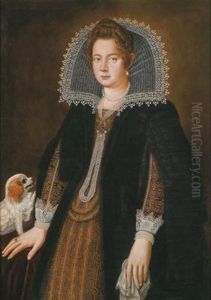Filippo Furini Paintings
Filippo Furini was an Italian painter who played a significant role in the Baroque period, particularly within the Florentine school. Born in 1604 in Florence, Italy, Furini's artistic journey was heavily influenced by his father, Filippo di Giovanni, who was also a painter, although not of great renown. This familial connection to art provided Furini with an early exposure to painting and the arts, setting the stage for his future career. Despite this, detailed records of his early training are scarce, but it is known that he was part of the vibrant artistic environment in Florence during a time when Baroque aesthetics were beginning to flourish in Italy.
Furini's work is characterized by a blend of the dramatic intensity of Baroque art with a distinctive, delicate sensuality. He was particularly known for his skill in painting the human figure, with a focus on soft, luminous flesh tones that give his subjects a lifelike presence. His religious and mythological scenes are imbued with a sense of emotion and intimacy, setting him apart from some of his contemporaries. Throughout the 1620s and 1630s, Furini developed a style that was profoundly influenced by the works of Caravaggio and Guido Reni, integrating Caravaggio’s dramatic use of chiaroscuro with Reni’s more graceful and idealized approach to figures.
Furini’s career also reflected the broader context of the Counter-Reformation, during which the Catholic Church encouraged artworks that were both emotionally engaging and doctrinally sound to counter the Protestant Reformation. His works, therefore, often carried moral and religious messages that were aligned with the Church’s objectives during this period. Despite the religious themes, Furini's paintings also reveal an interest in human vulnerability and the sensual aspects of his subjects, which was a somewhat daring approach at the time.
In addition to his paintings, Furini was known to have worked on frescoes, although fewer examples of these survive. His contributions to art were recognized in his time, and he received commissions from prominent patrons, including members of the Medici family, which was a testament to his skill and the esteem in which he was held.
Furini’s career, however, was relatively short-lived; he died in 1646 at the age of 42. Despite his early death, his work left a lasting impact on the Florentine art scene and continued to influence later generations of painters. Today, Filippo Furini is remembered as a significant figure in the Baroque movement, whose works continue to be studied and appreciated for their beauty and emotional depth.
